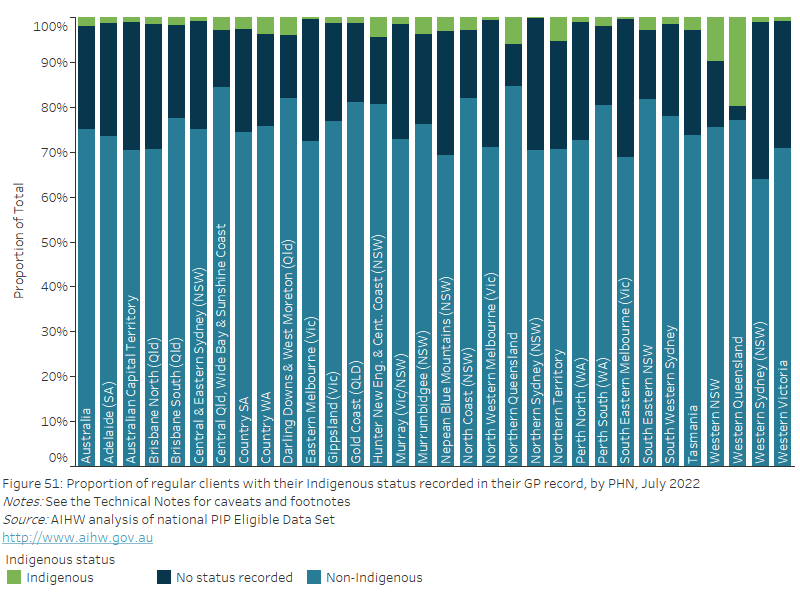Aboriginal and Torres Strait Islander data
The prevalence of disease among Aboriginal and Torres Strait Islander people is 2.3 times that of non-Indigenous Australians. Mental health and chronic diseases such as cancer, cardiovascular disease, respiratory diseases, diabetes and kidney disease are areas of particular concern (AIHW 2020c).
The health system’s response to this challenge involves a combination of private and public state and territory primary care providers and Indigenous-specific primary care providers. The establishment of PHNs in 2015 provided an opportunity to build connections across the health system to further improve access for Aboriginal and Torres Strait Islander people to appropriately targeted care that is effective and culturally appropriate (Department of Health 2016).
The 2020 National Agreement on Closing the Gap (DPMC 2020) is based on the partnership of governments and Aboriginal and Torres Strait Islander people working in and sharing decision-making to support better health and wellbeing outcomes for Indigenous Australians (AIHW 2020c).
It has been acknowledged that significant numbers of Aboriginal and Torres Strait Islander clients are being treated by mainstream practices and there is a recognised need for improvements in the rates of identification of Aboriginal and Torres Strait Islander clients (RACGP 2011).
Figure 51 shows, as of July 2022, nationally, of the regular clients aged 15 years and over:
- 1.9% of clients were recorded in their GP record as Aboriginal and/or Torres Strait Islander people
- 75.0% of clients were recorded in their GP record as non-Indigenous people
- 23.1% of clients did not have a record of Indigenous status in their GP record.
Aboriginal Community Controlled Health Services (ACCHS) and other organisations funded under the Indigenous Australians’ Health Programme (IAHP) do not submit data to this national PIP Eligible Data Set, and therefore are not represented within this report.
Figure 51: Proportion of regular clients with their indigenous status recorded in their GP record, by PHN, July 2022
This stacked bar chart shows the proportion of regular clients with their Indigenous status recorded in their GP record, by PHN for July 2022.

AIHW (2020c) Aboriginal and Torres Strait Islander Health Performance Framework 2020 summary report, Cat. no. IHPF 2, AIHW, Canberra, accessed 12 August 2022.
Department of Health (2016) Primary Health Networks (PHNs) and Aboriginal Community Controlled Health Organisations guiding principles, Department of Health, Canberra, accessed 12 August 2022.
DPMC (Department of Prime Minister and Cabinet) (2020) Closing the Gap In Partnership, Department of Prime Minister and Cabinet, Canberra, accessed 12 August 2022.
RACGP (2011) Identification of Aboriginal and Torres Strait Islander people in Australian general practice, RACGP, East Melbourne, Victoria, accessed 12 August 2022.


